英语人教版九年级全册unit5 Section B 2b
- 格式:docx
- 大小:55.69 KB
- 文档页数:8
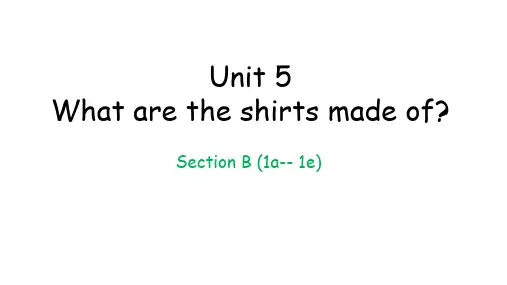
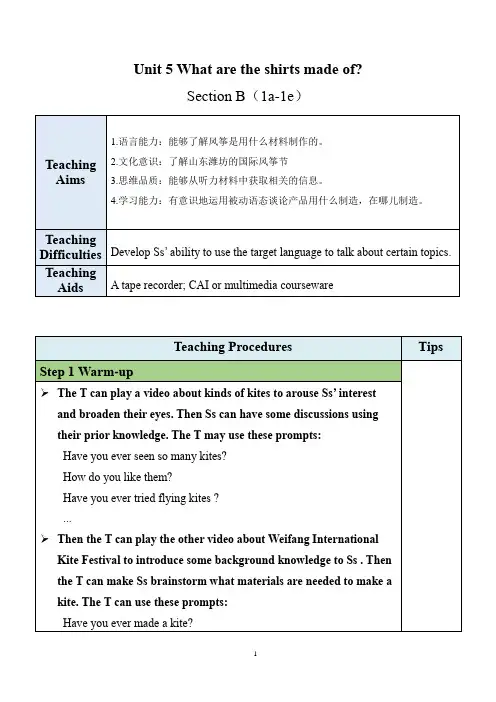
Unit 5 What are the shirts made of?Section B(1a-1e)Teaching Aims 1.语言能力:能够了解风筝是用什么材料制作的。
2.文化意识:了解山东潍坊的国际风筝节3.思维品质:能够从听力材料中获取相关的信息。
4.学习能力:有意识地运用被动语态谈论产品用什么制造,在哪儿制造。
TeachingDifficulties Develop Ss’ ability to use the target language to talk about certain topics. TeachingAids A tape recorder; CAI or multimedia coursewareTeaching Procedures Tips Step 1 Warm-up➢The T can play a video about kinds of kites to arouse Ss’ interest and broaden their eyes. Then Ss can have some discussions usingtheir prior knowledge. The T may use these prompts:Have you ever seen so many kites?How do you like them?Have you ever tried flying kites ?...➢Then the T can play the other video about Weifang International Kite Festival to introduce some background knowledge to Ss . Thenthe T can make Ss brainstorm what materials are needed to make akite. The T can use these prompts:Have you ever made a kite?What materials or tools do we need to make a kite?Then the T can list the materials and tools on the board so that Ss can have a review of these words and phrases.Step 2 Presentation & Practice➢1aThis activity is to review the target language for talking aboutwhat things are made of. If feasible, the T may bring one or twokites to class and have Ss identify the materials used to make those kites. Alternatively, the T may ask Ss prior to this lesson to bring any kites they might have for this lesson.➢1aSs look at the pictures in 1a and the T can ask some questions such as“Are they bees? Are they flies? Is this a butterfly? ” to help Ss toreview the learned words. Ss finish the task in 1a and share their answers by making conversations using the target languagestructure in pairs.Suggested answers: paper, silk, nylon, wood/bamboo➢1bBefore-listening, the T can ask Ss to look through the context in 1b to predict. The T may use these prompts:If Laura wants to know what Zheng Yun did on his vacation,she may ask Zhang Yun:What did you do …?What happened …?What took place …?If Laura wants to know what Zheng Yun thinks about Weifang,she may ask Zheng Yun:How is …?How do you find …?How do you like …?➢1bThe T can play the recording and Ss finish the task in 1b. Then the T can invite some Ss to share answers by asking the followingquestions and then the T can make feedback.What is Laura trying to find out more about?Does Zheng Y un tell Laura about a kite festival or how to make akite?Why did you choose that answer?Answers: 1.A 2.A➢1bAfter Ss have completed activity 1b, the T may want to ask Ss to listen to the recording again and identify the superlatives used to describe the kites. (best/highest)➢1cThis activity is to give Ss practice in listening for specificinformation. The T can ask Ss to look through the sentences in 1c before playing the recording .Ss finish the task in 1c and the T can nominate Ss to share their answers .Answers:1.Z2.L3.Z4.L5.L➢1dThis activity is to give Ss further practice in listening for specificinformation. Before playing the recording again, the T can have Ss work in pairs to predict answers in 1d so that they can be morefocused when listening. Then the T present the correct answers.Answers:1.kites2.April3.all over the worldpetitions5.silk or paper; drawings.➢1eTo provide Ss with speaking practice using the target language, the T can invite Ss to role-play the conversations between Laura and Zheng Yun. Or make them work in closed pairs. The T can observe the Ss’ performance and provide support when necessary.Other options:The T may have Ss work in pairs to make a conversation aboutother festivals they have been to, then invite a few pairs torole-play their conversations for the class.Step 4 Language points learning➢international adj. 国际的international作形容词,由“inter-(前缀)+ nation(n. 国家;民族)+ -al(形容词后缀)”构成。
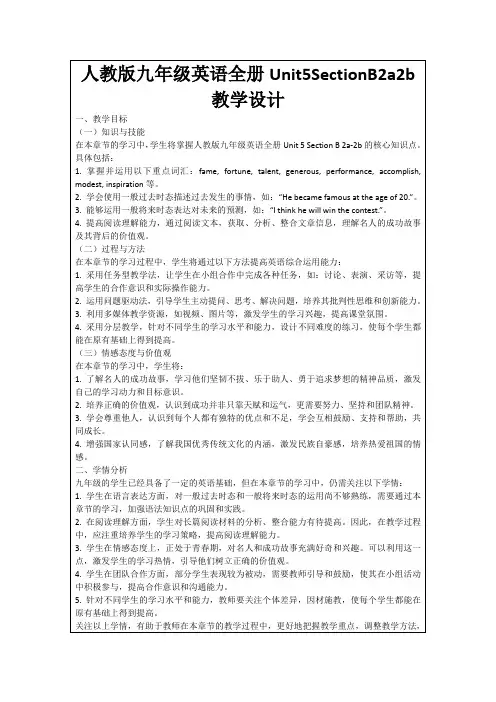
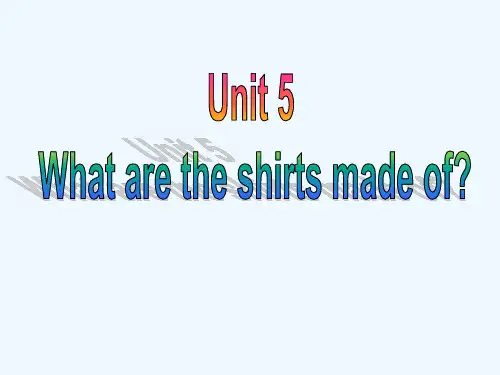
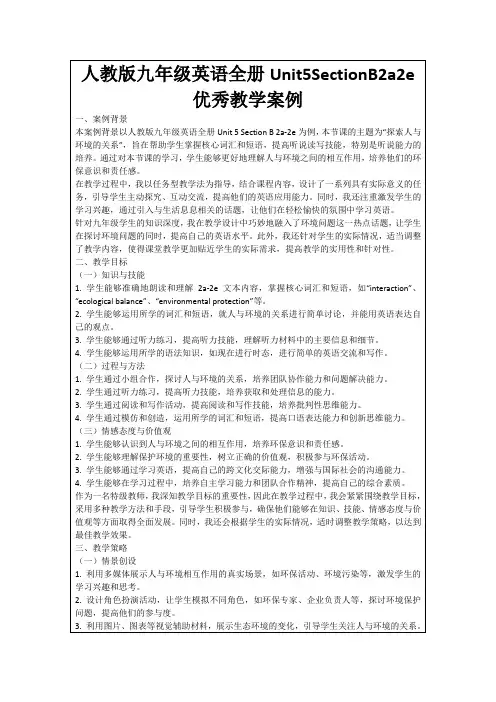
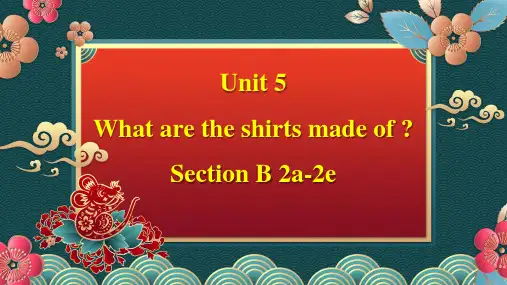
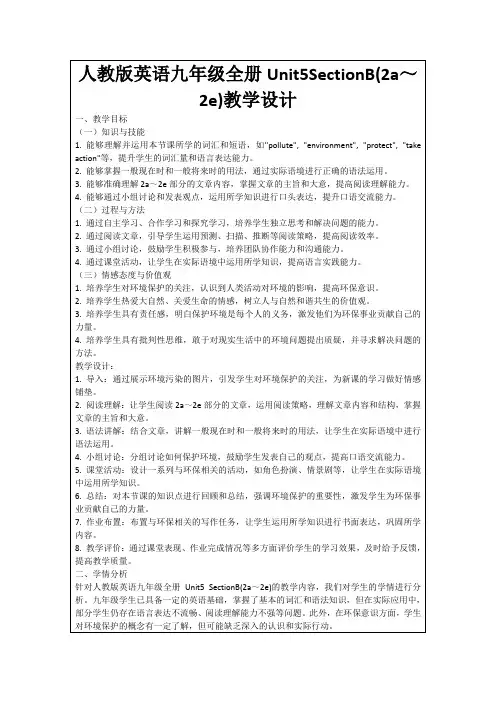
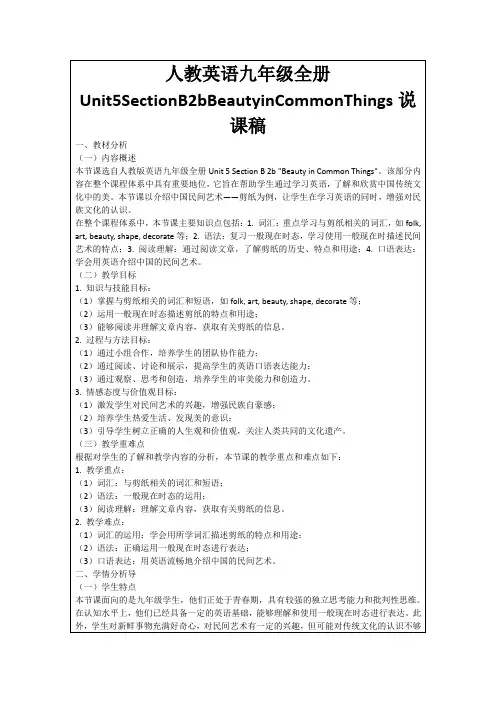
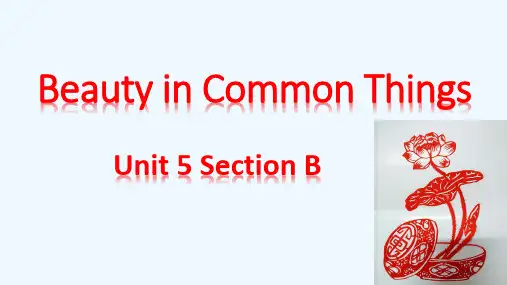
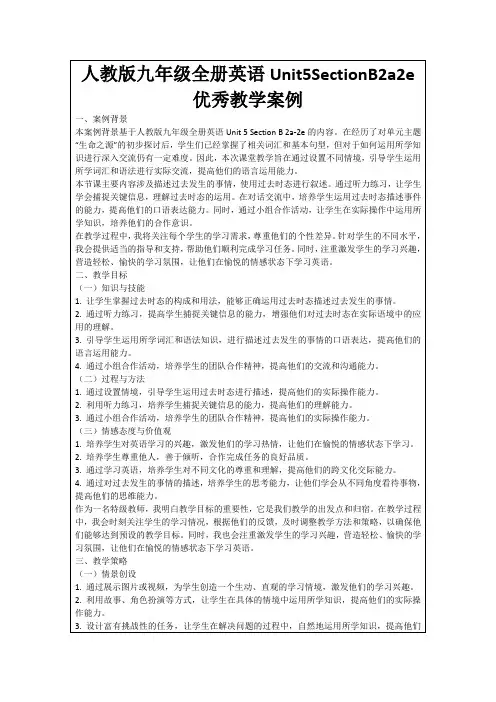
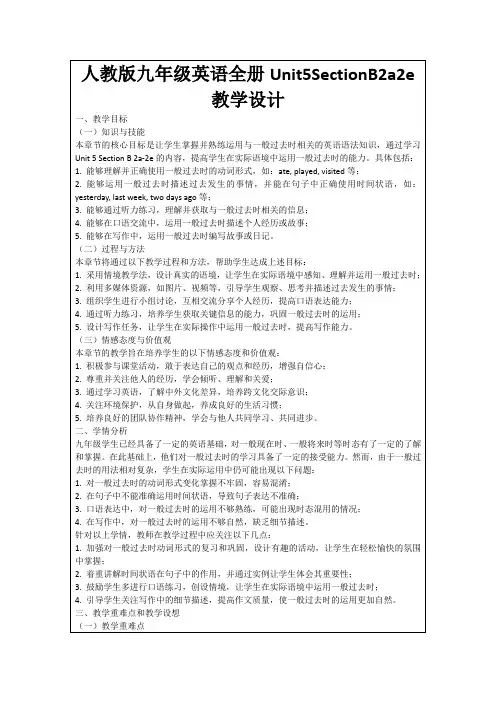
人教版九年级Unit 5 What are the shirt s made of?Section B 2a~2b Beauty in Common Things一、教学设计(一)教学目标1.语言知识:1) 能掌握并运用介绍中国传统艺术的相关词汇:its, form, clay, celebration, balloon, paper cutting, scissors, lively, fairy tale, historical, heat, polish, complete,turn...into, such as, send out.2) 能运用介绍传统艺术的相关句型:① They are made of….② According to Chinese history, sky lanterns were first used by…③ They are seen as bright symbols of…④ After drying, they are fired at a very high heat.3)能掌握并合理运用一般现在时的被动语态2.语言技能1)听:学生能够听懂教学活动内容及课堂用语。
2)说:学会谈论中国传统艺术形式,并能根据交际需要运用英语与伙伴和老师交流。
3)读:能够根据需要运用略读、跳读、细读等方法理解文章,掠取有效信息以解决问题,并掌握阅读技巧:从文章大意到具体细节等。
4)写:能够通过阅读搭建图式支架,积累写作素材,实现知识迁移并进行创作,即撰写说明文:介绍家乡的传统艺术形式,并完成书面作业。
3.文化意识1)了解中国的传统文化元素,领略中国传统艺术形式的魅力,加深对祖国文化理解的过程。
2)学生初步形成跨文化交际意识,能初步用英语介绍祖国的优秀传统文化。
4.情感态度1)学生对祖国传统艺术形式能有更深刻的了解,具有初步的国际理解意识。
2)通过详细了解中国传统工艺品和家乡优秀传统艺术,树立民族自豪感及爱国、爱家的情怀。
Unit 5 Section B 2b Beauty in Common Things一、整体设计思路这是一节阅读课,选取的文章是人教版Go for it! (2014 年版)九年级Unit 5 Section B 2b Beauty in Common Things 并以此作为写作范例,进行写作练习。
1. 对阅读篇章的文本处理,先让学生根据本课提供的阅读策略,整体感知文章的主旨大意,归纳出“总-分”的篇章结构。
然后再逐段阅读,获取文章每个段落的具体信息,再要求学生过渡到整体,以思维导图的形式呈现全文的脉络结构。
2. 在写作练习部分,主要采取文章仿写的方式,包括仿写阅读篇章的结构、衔接方式和语言表达等,同时鼓励学生结合实际,发挥想象,自由表达。
二、教材分析本节课的主要话题是让学生通过对几种中国传统艺术的阅读,让他们掌握从概括到具体的阅读策略的同时,明白如何用被动语态描述物品及产地,并巩固复习被动语态的构成及其应用。
三、教学目标1. 知识目标:(1)掌握重点单词和词组:form, clay, celebration, balloon,paper cutting, scissors, lively, fairy tale, historical, heat,polish, complete doing, turn into, add to, be covered with, in trouble, objects of beauty, send out, a Chinese fairy tale, sky lanterns, at a very high heat, according to.(2)通过学习本篇阅读,让学生感知、复习并运用本单元核心语法内容: 一般现在时被动语态the Simple Present Passive Voice ( am/is/are + done)2. 技能目标:(1)培养学生的阅读技巧,如通过关注每段句首和句尾,快速掌握文章主旨大意的能力,思维导图的形式,分析文章脉络的能力。
Unit 5 Section B 2b Beauty in Common Things一、整体设计思路这是一节阅读课,选取的文章是人教版Go for it! (2014年版)九年级Unit 5 Section B 2b Beauty in Common Things 并以此作为写作范例,进行写作练习。
1.对阅读篇章的文本处理,先让学生根据本课提供的阅读策略,整体感知文章的主旨大意,归纳出“总-分”的篇章结构。
然后再逐段阅读,获取文章每个段落的具体信息,再要求学生过渡到整体,以思维导图的形式呈现全文的脉络结构。
2.在写作练习部分,主要采取文章仿写的方式,包括仿写阅读篇章的结构、衔接方式和语言表达等,同时鼓励学生结合实际,发挥想象,自由表达。
二、教材分析本节课的主要话题是让学生通过对几种中国传统艺术的阅读,让他们掌握从概括到具体的阅读策略的同时,明白如何用被动语态描述物品及产地,并巩固复习被动语态的构成及其应用。
三、教学目标1.知识目标:(1)掌握重点单词和词组:form, clay, celebration, balloon,paper cutting, scissors, lively, fairy tale, historical, heat,polish, complete doing, turn into, add to, be covered with, in trouble, objects of beauty, send out, a Chinese fairy tale, sky lanterns, at a very high heat, according to.(2)通过学习本篇阅读,让学生感知、复习并运用本单元核心语法内容: 一般现在时被动语态the Simple Present Passive Voice ( am/is/are + done)2.技能目标:(1)培养学生的阅读技巧,如通过关注每段句首和句尾,快速掌握文章主旨大意的能力,思维导图的形式,分析文章脉络的能力。
(2)培养学生根据重点单词和词组复述课文的能力。
(3)通过文章仿写,培养学生的写作技巧,如分段写、运用主题句和连接词等。
3.情感目标:通过介绍中国的传统艺术,了解与中国传统文化艺术相关的风俗习惯和文化背景,提升民族自豪感。
四、教学重点和难点1.培养学生通过扫读和略读快速获取文章主旨大意的能力,和运用思维导图梳理具体信息的能力,提高学生的语篇理解力和阅读效率。
2.通过对所选文章的结构与语言特点的分析,帮助学生总结归纳写作技巧,并运用于实际写作中。
五、教学策略根据本课教学目标和重难点,采用扫读、略读、画思维导图、双人活动、小组讨论、仿写等活动来引导学生自主学习。
六、教学用具多媒体、课件七、教学过程Stage1:Warming upStep1: GreetingStep2: Check the previewReview the new words and phases by doing some exercises, such as translating the new words from Chinese to English or from English to Chinese, and completing the sentences.Stage2: Pre-readingStep 1: Lead-inTask 1: Free Talk1.Ask the students to talk about some traditional art in their daily life.T: Do you know any forms of traditional art in our country?Ss: Beijing Opera in Beijing, Face-Chaning in Sichuan, lion dance in Guangdong, tiger-head shoes in the northern part of China...The conclusion is that each different part of China has its own special forms of traditional art.2.The teacher shows some pictures about more special forms of traditional art in different parts of China. Then, ask the students some questions:①What do you think of these forms of traditional art?②If you have a chance, which one do you want to learn? Why?Task 2: Using reading strategy ( Prediction )Ask students to read the title and look at the pictures in the text, then try to guess the main topic of the passage.(Reading strategy - Prediction: We can predict what the passage may talk about according to the topic and the pictures of the text.)Stage3: While-readingStep 1: Scanning ( Reading for structure)Ask students to read the passage quickly and find out the structure of this passage. The teacher will give students some questions to help them.Questions:1.How many forms of traditional art are mentioned in the passage? What are they?Ss: Three. They are sky lanterns, paper cutting and Chinese clay art.)2.How many parts can the passage be divided into? And then, get the main idea of each part.Part 1( 1 ) : A general introduction of the Chinese traditional art.Part 1( 2 - 4 ) : Some specific details and examples of the Chinese traditional art.3.How does the writer organize the passage?( the first one )4. Ask the students to draw a mind map for the whole passage.(Reading strategy: Moving from general to specific - a general introduction of the topic is usually followed by specific details and examples.) Step 2: Skimming ( Reading for information)Task 1: Ask the students to read Part1 again, then answer the following question and complete the sentences.T: What do you know about Chinese traditional art according to para.1? ① Each part of China has its own special forms of traditional art.② They try to show the things that are important in life, such as love, beauty and family. ③ The most common things can be paper,clay and bamboo.Task 2: Ask the students to read Part2 again, and finish the following chart in according to the paragraph 2, 3 and 4.Task 3: Pair workAsk students to work in pairs and read paragraph 2, 3 and 4 again. Try to find out more specific information about sky lanterns, paper cutting and Chinese clay art, and draw a more detailed mind map for each of them. Then, ask some pairs to present their mind maps to the class.Ta sk 4: Group workAsk students to work in groups and have a discussion about the main aspects of describing traditional art. Then, draw a mind map about how to describe traditional art.Stage 3: Post-readingTask 1:RetellingAsk the students to retell the passage according to the key words given to them.Para.1: General introduction: art forms / symbols / common things / objects of beautyPara 2: Sky lanterns: history / today / materials / appearance /symbolsPara 3: Paper cutting: history / material / common pictures / symbolsPara 4: Chinese clay art: material / appearance / symbols / making stepsTask 2: Language pointsAsk Ss to underline the difficult language points in the passage, and discuss in groups. Then, the teacher explain some important language points.Eg:1.These usually try to show the things that are important in life,such as love,beauty and family.such as和for examplesuch as常用来列举同类人或事物中的多个例子。